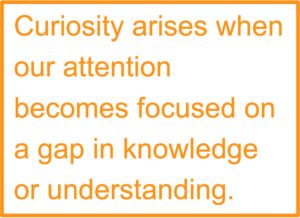Bias #179: Curiosity Bias; 8-minute read
Defined:
Curiosity Bias: “A cognitively induced deprivation that arises from the perception of a gap in knowledge and understanding.”
Described:
Have you ever been curious about curiosity? Behavior change requires motivation, and curiosity can be a powerful force. But it’s also a bit of a mystery. So, what is it, how does it work, and how can we leverage it to nudge people to action?
The Mystery of Curiosity
Over the years people have tried to explain curiosity in different ways. Some thought it was simply an intrinsic desire for information. Others viewed curiosity as an attraction to novelty, a passion or an appetite. Still others imagined curiosity was nothing more than the desire for stimulation to overcome boredom.
While each of those theories acknowledged some aspect of curiosity, they left others unanswered. For example, it’s true that curiosity can be stimulated internally by boredom, but it can also be triggered by external stimuli. If a friend says, “guess what juicy news I just heard?,” your curiosity is piqued.
Or, how do you explain the fact that curiosity is aversive? When we experience it, we try to make it go away. But we also voluntarily seek it out by reading mystery novels or attempting to solve puzzles. And curiosity exhibits other traits that weren’t addressed by those theories like its transient nature—it comes and goes—and its intensity.
Curiosity is curious indeed.
Closing the Curiosity Gap
 In a paper titled the Psychology of Curiosity: A Review and Reinterpretation, published in 1994, psychologist George Loewenstein of Carnegie Mellon University introduced a definition of curiosity that did a better job capturing curiosity’s many traits. Loewenstein theorized that curiosity was a gap in knowledge or understanding. He believed curiosity arose when attention became focused on one of those gaps.
In a paper titled the Psychology of Curiosity: A Review and Reinterpretation, published in 1994, psychologist George Loewenstein of Carnegie Mellon University introduced a definition of curiosity that did a better job capturing curiosity’s many traits. Loewenstein theorized that curiosity was a gap in knowledge or understanding. He believed curiosity arose when attention became focused on one of those gaps.
Information gaps, he theorized, produce the feeling of deprivation we call curiosity. A curious individual is motivated to obtain the missing information to reduce or eliminate that feeling of deprivation.
Two factors define information gaps: what one knows and what one wants to know. Interestingly, this means one can only be curious about topics where one has some existing knowledge. Curiosity, therefore, should be positively related to one’s knowledge in a particular domain—and it is. As people gain information about a topic, they become more likely to focus on what they do not know—the gaps. Lowenstein provides an example. If someone knew the capitals to 3 of the 50 states, they are likely to frame their knowledge in terms of what they know. E.g., “I know 3 state capitals.” However, if they know 47 of 50 state capitals, they are likely to frame their knowledge in terms of what is missing. E.g., “There are 3 state capitals I don’t know.”
“This shift is the genesis of curiosity because, at that moment,” according to Loewenstein, “the individual suddenly becomes focused on the gap in his or her knowledge. This suggests that curiosity is unlikely to arise in the absence of an existing knowledge base and that the likelihood of experiencing curiosity should increase as an individual obtains information about a particular topic.”
Empathic Curiosity
We are not limited to feeling our own curiosity. A few years ago, after watching the movie Pirates of the Caribbean III, my son Dominic approached his sister Shelby and said, “You are not going to believe what happens to Will.” Dominic knew that Shelby had seen the first two movies and knew the character named Will. He also knew she hadn’t seen the third movie and would be unaware of Will’s fate. So, like a typical big brother, he picked on his younger sister by making her aware of the gap in her knowledge because he knew it would bother her. That’s not unexpected. What happened next, was.
After Dom revealed Will’s fate to Shelby, she came downstairs to her mother and me and asked, “Can I tell you what happens to Will?” Shelby knew Amy and I had seen the first two movies and knew the character named Will. But she also knew we hadn’t seen the third film and were unaware of his fate. The gap in our knowledge bothered her and she would not be satisfied until she closed it.
When we sense someone else’s knowledge gaps, we are motivated to close them to satisfy ourselves!
Leveraging Curiosity
Create or reinforce a knowledge base, then highlight what’s missing.
You can generate curiosity for matters where your audience has no—or very little—existing knowledge in two easy steps.
- Build a foundation by providing some knowledge on the subject.
- Punch a hole in it by drawing attention to missing information.
Here’s an example. Most people couldn’t tell you which states had the fewest coronavirus restrictions and they might not care. But if you told them the top five states are 1. South Dakota, 2. Utah, 3. North Dakota, 4. Missouri and 5. ______________, they would be curious to learn the one that’s missing.
Want to generate even more curiosity? List them in reverse order. “The top five states with the fewest coronavirus restrictions are 5. Idaho, 4. Missouri, 3. North Dakota, 2. Utah and 1. _________.”
Why does that work? My theory is that the first position enjoys a special status. It is the ultimate, whereas the fifth position is just another number on the list. I believe people assume the top item on a list is more popular, making those who don’t know it further out-of-touch compared to the general population. There’s no shame in failing to name an NFL playoff team from two years ago, but you’re expected to know the Super Bowl champ.
Magnify curiosity by narrowing the gap.
Curiosity increases as people draw closer to completing the reference set of information. Someone who knows 45 of the 50 state capitals (the reference set) will be more curious about the missing information than someone who knows 40 of the 50 state capitals.
To increase curiosity, you can narrow such gaps in one of two ways.
- You can reduce the gap by providing some of the missing information. If someone knows the capitals for 40 of the 50 states, you could close their gap and increase their curiosity by providing the capitals for some of the missing states. If you told them six of the missing capitals, only four would remain and their desire to know them would increase.
- You can also reduce the gap by reducing the size of the reference set. Suppose someone knew the capitals of Illinois, Indiana, Michigan, Minnesota and New York, but no other states. You could say they knew the capitals for five of the 50 states. However, that framing is unlikely to pique their curiosity because it focuses on what they know rather than what’s missing. But if you change the reference set to Great Lakes States instead of all 50, you can say they know five of the eight Great Lakes States—a frame that narrows the gap from 45 to 3 and piques curiosity by focusing their attention on what’s missing.
The Takeaway
Curiosity is a powerful force that can lead people to open email messages, click links, and read articles. Best of all, you can generate it and intensify it whenever you like. Now that you know how, please use it for good.
Ready to See Real Behavior Change at Your Organization?
About the author:
This Bias Brief was written by Greg Stielstra, the Senior Director of Behavioral Design at Lirio. Greg is a behavior change expert and published author with over 25 years of experience applying behavioral science to marketing and engagement.
References:
- Loewenstein, George. “The Psychology of Curiosity: A Review and Reinterpretation.” Psychological Bulletin
Other readers viewed:
Social Proof – Lirio Bias Brief
Cognitive Fluency – Lirio Bias Brief
Loss Aversion – Lirio Bias Brief
